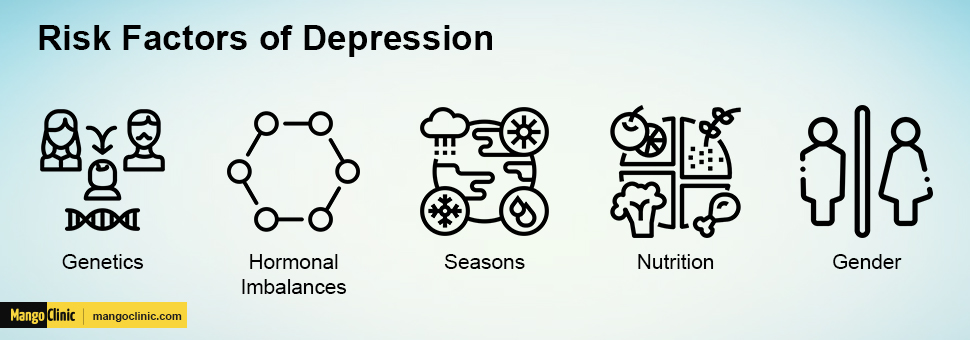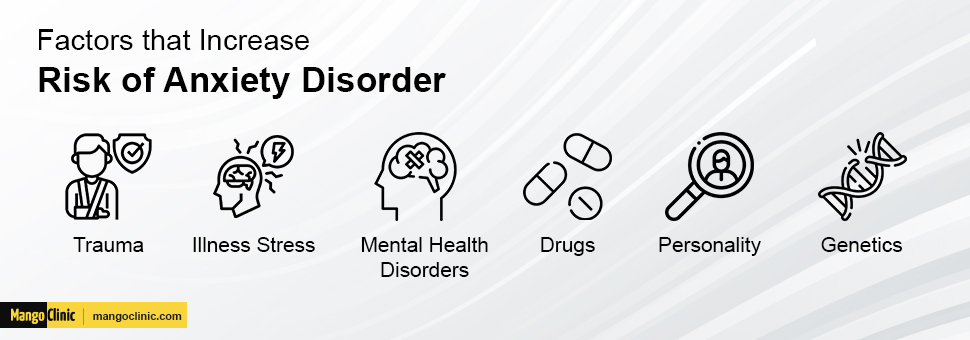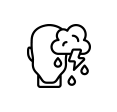9 Unpopular Facts about Depression that Will Blow Your Mind Away!

Today, let’s dig into nine important facts about the great depression that will blow your mind away. The facts are well researched with lots of evidence to back them up. Following these facts, there has been a lot of emphasis on depression and resulted in a new way of looking at this mental health disorder. You will find these facts about depression interesting to know.
Want help with depression? Click the button below to book your appointment.
Table of Contents
1. Brains of People with Depression Look Different
By now, you know that depression is a complex disease. It has different factors going around in the background. Among the things that go on behind the scenes include trauma, changes in chemical composition, medical conditions, and genetics. All these factors lead to changes in the brain structure, which makes it look different from a person who isn’t suffering from depression.
The following are the significant changes that are evident in the brain of a person suffering from depression:
-
Differences in Brain Structure
Following comprehensive scans of the brains of people with depression, major changes in the structure were witnessed. One of the major concerns is changes in white matter, which was prevalent.
What’s the Role of White Matter in the Brain?
White matter is the communication channel of brain cells. The white matter contains signals that pass information between cells in the brain. Through this signaling, information moves around the brain. When the white matter is interfered with, one develops problems touching on emotions, cognition, and the thought process.
When one has depression, their brain may not function properly. Some of the areas that are under threat when one has depression include:
- Thalamus
- Amygdala
- Frontal
- Prefrontal cortices
Brain shrinkage may occur, and its severity depends on how long one has suffered from depression.

Is Depression Classified as an Inflammatory Disorder?
When one has persistent depression, one may develop inflammation. However, it’s yet to be established whether it’s depression that causes inflammation or vice versa.
- Functional Differences
Let’s look at these top things:
The three areas of the brain that undergo significant changes include:
- Hippocampus – Damage on this part of the brain leads to impaired memory.
- Prefrontal Cortex – Affects attention.
- Amygdala – Alters one’s behavior and attention.
During the last stages of depression, the changes to the brain’s functionality may penetrate the victim’s genes.
Hormonal imbalance is also common in people suffering from depression. In these people, the stress hormone, cortisol, is produced more than that in normal people. A person with elevated levels of cortisol is likely to suffer from ‘Cushing syndrome.’ As you can see, the process is cyclical. High levels of cortisol are a major cause of the significant depressive disorder.
- Biochemical Differences
Any type of damage caused by a disorder isn’t superficial. It begins at the molecular level and piles up through many biochemical changes that cause havoc on the entire body. Following these changes, you will start experiencing the effects on every part of your body.
There’s nothing romantic about the chemistry of depression.
Here’s the thing, the brain is in charge of all the body’s functions. When one has depression, things begin to go wrong. Every molecular activity in the body starting from the brain is affected. These changes shift the body from its normal operation to fight and flight mode. The shift results in a chemical imbalance that may be influenced by genes, trauma, or the environment.
- Changes as Seen on a Brain Scan
The future of medicine is hopeful that an MRI will help detect all types of brain issues. While you might assume that changes are limited to functionality and structure, such an assumption is wrong. Before we look at the difference between the two, let’s explore some interesting knowledge about a brain scan. Things that a brain scan can detect. If there’s a diagnostic wonder in the world of medicine, it’s a brain scan. Whether it’s a tumor, changes in brain structure, lesion, unusual formations, or anything else, a brain scan will pick it up.
Brain scans fall into two main categories: a Computed Tomography (CT) scan and Magnetic Resonance Imaging (MRI). The two offer highly diagnostic insight on various brain-related diseases.
Between an MRI and CT scan, which is better? The two are equally good and have been endorsed by doctors in the detection of brain anomalies. The two can detect four different types of brain disorders. As you may know, depression has time and may relapse. When a depressive period occurs, you may not be aware of the triggers. There are specific triggers that cause depression.
Contact us today for depression treatment or click the banner below to book your appointment.

In the following fact, you will get to learn about different triggers of depression.
2. Depression Is Triggered by Multiple Factors
We all feel low from time to time. Various factors, such as losing a job, arguing, or the presence of grey clouds in the sky, can make one sad. In some cases, depression may set in from nowhere without any triggers. However, clinical depression is different from ordinary depression. It’s a medical disorder that has specific triggers. Such depression usually manifests in a myriad of symptoms. Let’s dig into some of the triggers.
-
Being Overworked at the Workplace
Reports by the American Institute of Stress, the primary causes of depression disorder are caused by stressors at the workplace. However, most people who can’t handle extreme pressure at the workplace are at substantial risk of developing many mental health disorders, including depression. Work pressure may be out of our control. The two available options are looking for an alternative job or developing a coping mechanism for the work overload.
-
Body Inflammation
There’s a new radical approach to comprehending depression that links the disorder to inflammation in the body. Is depression caused by inflammation in the body? Most people don’t know this, but inflammation in the body is a big problem. Complex systematic inflammation affects various critical symptoms in the body, such as the respiratory system or the musculoskeletal system. The impact of these disruptions causes a big mess in the body. It’s not a coincidence that there’s a connection between the brain and inflammation.
What are the common causes of inflammation?
- Trauma
- Sleeping disorder
- Illness
- Infection
Inflammatory proteins such as cytokines contain an active inflammatory cascade. When such proteins reach the brain, they lead to reactive oxygen species, among other byproducts, which may cause stress on the body and lead to depression.

Jumping on to,
-
Financial Distress
There’s a high correlation between financial woes and depression. The two are like milk and butter. Why is this? When one has financial problems, they can’t make money, and they lag on bills, pile up tickets, and other liabilities that drag their mood down. Furthermore, the lack of money entangles one in a vicious cycle. 50% of people with depression are usually on leave or don’t have a job. I hope you can see the chain here? When you compare yourself to your peers who are ahead of you financially, you may end up getting depression. People suffering from depression due to lack of money may isolate themselves, which makes the situation worse.
-
Sexual Dysfunction
There’s a co-existence between depression and sexual dysfunction. How so? When one experiences problems in their sexual life, they may not open up to anyone, including their physician. As a result, depression keeps growing inside them. What’s worse is that your antidepressants can cause sexual dysfunction. Between 16 and 20% of American women are taking antidepressants. The above high figure shows that women are prone to depression due to the sexual dysfunctions that they may be experiencing. Moving on to,
-
Obesity
We live in a world where being big is perceived as unhealthy. People with weight issues often fall into depression due to the stigma associated with the extra pounds. Most of you here would also struggle with depression if you added weight excessively. The worst thing that drives people into more depression is when they can’t seem to shed the extra weight.
How Does Obesity Trigger Depression?
Obesity is a tough conversation among most people. Those suffering from it are in denial and don’t want to admit that there’s a problem. Most of these people keep quiet about any struggles they may be going through due to their excess weight, and this leads to chronic depression. When feeling like your weight is pulling you down, seek therapy. It works!
-
Excessive Consumption of Alcohol
Most people may not know that their mental health is greatly influenced by what they eat or drink. Social drinking has been on the rise among Americans, and more people are slipping into alcohol addiction by the day. Various types of depression are occurring due to alcohol and substance abuse. The main problem is that people are using alcohol to help them forget about their problems. Drinking alcohol is seen as an escape from one’s problems. Such a mentality can cause depression.
Here’s an essential question:
What’s the Effect of Alcohol on One’s Mental Health?
Once you start drinking, there’s this euphoric feeling, and one gets into a mellow mood. But once you sleep and the effects of the alcohol wear out, you are brought back to reality. The wake-up call triggers episodes of depression and anxiety. Once sober, you may even contemplate suicide.
So, Why Do You Feel Worse once You Stop Drinking?
Alcohol and most other substances manipulate your body’s physiology and can be highly addictive. Once you stop drinking, you will go through withdrawal symptoms as the body tries to wean itself from the effects of the alcohol. Alcoholic beverages contain high amounts of carbohydrates. Withdrawal from taking these drinks deprives the body of these carbohydrates and may cause mayhem. As you stop taking alcohol, the body craves these carbohydrates, and the result is depression and becoming irritable.
Get proper treatment for depression from expert doctors. Click the button below to book your appointment.
3. Over 65% of Depression Is Confused with Anxiety over Time
It’s common to confuse depression with anxiety or vice versa. The two mental health disorders have similar symptoms. Since they revolve around one thought pattern, 65% of people confuse depression with anxiety. So how can you tell the two conditions apart? Don’t worry; you are in the right place to get the information you need about these mental health disorders. The two common disorders that are often interlinked are ‘Major depressive disorder (MDD)’ and ‘Generalized anxiety disorder (GAD).’ Surprisingly, most people are suffering from both. Are you wondering whether you have both anxiety and depression? Here are some symptoms that may help you figure that out:
When you have anxiety and depression, the symptoms may be intense. The truth is that if you have anxiety, the chances of getting depression are high. It’s common to be diagnosed with both depression and anxiety. The treatment options available for the two are almost similar, especially if you are experiencing them at the same time. For both, you may be prescribed antidepressants. The two also involve cognitive behavioral therapy, making some lifestyle changes, and correcting sleeping patterns. While both disorders have different features, most of their attributes often overlap. It’s highly common for people to suffer from the two at the same time.

Let’s proceed to the next fact:
4. One of the Main Causes of Suicide Is Untreated Depression
The rate at which people are committing suicide due to depression is rising at an alarming rate. The mental disorder causes major changes in behavior in the victim.
The thing is, knowing what’s going on in one’s mind is extremely difficult. Unless someone takes you through their thought process, you will remain in the dark. When it starts having problems and falls into depression, they may start isolating themselves from friends and family. They also withdraw from social interactions that they used to find enjoyable. If you notice such trends in a person, chances are they are slowly slipping into depression. The worrying thing is that such behavior may lead to suicidal thoughts. A person suffering from depression often believes that taking their own life will put them out of their misery. Usually, suicidal thoughts are passive. The victims begin to fantasize and ask themselves,’ ‘what if I was dead?’ or ‘what if I die?’ ‘Could suicide be the permanent solution to my problems?’ Some red flags to look out for a suicidal person are when they start giving away personal belongings or when they start acquiring a firearm. These are indications that the person could be contemplating suicide.
Never ignore any red flag that points to suicidal thoughts. Over time, there’s a trend in the correlation of suicide to depression between genders. For men, about 7% are prone to suicide as a result of depression compared to 1% of women in a similar situation.

How Can You Detect if Someone Can Be Suicidal?
Predicting whether someone is likely to commit suicide isn’t easy. However, some warning signs point to the possibility of suicide. They include:
- Prolonged periods of mental instability
- Social isolation
- Loss of meaning in life
- Drastic changes in one’s behavior and personal hygiene
- Mood swings
- Disposing of personal possessions
Apart from these, there are other warning signs such as:
Verbal Cues – A suicidal person may repeatedly utter specific phrases such as ‘I want to die’ or ‘You will miss me.’ Most suicidal people will try to reach out to the people around them using such phrases, which is usually a cry for help.
High-risk People – Depression often manifests in different ways in people and alters their thinking patterns. For people at a high risk of killing themselves, are often preoccupied with death and often wonder how it can’t be reversed. Such people tend to be fierce and impulsive. When these people know of someone close to them who committed suicide due to depression, they may be motivated to do the same to also get out of their despair.
Suicidal people fall into two categories: those that are determined to die or those that are desperate for help. Simple.
Save yourself from chronic forms of depression. Click the button below to book your appointment.
Let’s move on to the fifth fact:
5. Children Also Suffer from Depression
Is your child always unhappy? Are they pulling away from their friends? Naturally, children hate darkness. Is your child always isolating themselves and staying in a dark room for hours? Well, you will be amazed to learn that children are not immune to depression. As sad as that sounds, it’s a fact.
Why Do Kids Fall into Depression?
Let’s explore this together. According to statistics, about 2 to 3% of children under the age of twelve suffer from clinical depression. While this number may be low, it’s still sad to think about it. Kids are always full of life and have lots of energy. However, mistreating or abusing them steals this innocent joy from them. While not every child that’s abused may suffer depression, it’s still a significant trigger of depression in kids. The correlation between child abuse and depression is high.
The rate of depression among teenage girls has skyrocketed over the past decade. Over the same period, the rate of suicides has doubled among this age group. Parenting the current generation is no easy feat. Children are under a lot of pressure nowadays. At this age, children don’t know how to express sadness or open up about any emotional issues they may be having.
Another contributing factor is the generational gap in how things should be in society. Most children don’t see anything wrong with playing violent video games or using their smartphones to access social media and participate in the hype there. However, most parents believe that this is a big NO.

There’s no denying that children in the current generation spend a huge amount of time on the internet using their smartphones and laptops. It can be tough to supervise what they are watching and what’s in their mind. However, it’s your responsibility to monitor them and check their phones once in a while. You can also look into their social media accounts or browser history to try and understand what’s going on in their mind. Don’t overlook depression in children. Ensure there’s an open communication channel between you and your kids.
6. Depression Can Be Cured Using Magnets
How cool is that? This little piece of information right here is revolutionizing the treatment of depression. Sometimes depression can be resistant, and the solution lies in Transcranial magnetic therapy. I am sure you think that this method involves the physician placing a magnet on your head that sucks out the depression. No. Transcranial magnetic therapy (TMS) involves the use of powerful electromagnets similar to those used in an MRI. Your brain is an electric organ, and there’s a high correlation between electromagnets and electricity.
How Do Magnets Help Your Brain?
The newest research on neurocognitive abilities involved the use of magnets. The solution can be used to improve one’s sleeping patterns and eating habits. Magnets can manipulate your brain. Using them may help one’s cognitive ability and improve memory. In 2008, the FDA approved the use of magnets to improve brain functions. Over the years, the success of the treatment has increased tremendously. Some therapists believe that TMS has similar effects to taking antidepressants. Combined with other psychotherapy techniques, the results are amazing.
REALITY CHECK!
According to the World Health Organization, over 350 million people are suffering from depression around the world. This figure makes it the leading cause of disability. 30% of the world’s population is said to be resistant to various forms of depression treatments. The term resistant to treatments refers to the situation where a patient is still exhibiting symptoms of depressions even after two or three cycles of taking antidepressants.
The science behind how TMS operates is still sketchy, but there are different procedures of carrying it out. TMS is painless and works by sending electric impulses to the brain, which in turn stimulates the cells, which helps control one’s mood and behavior. However, the method is relatively new and comes with certain risks. Let’s check them out.
Transcranial brain stimulation is a non-evasive procedure – there’s no surgery involved. Repeating the process hasn’t caused any adverse effects. However, there are some side effects, such as:
- Headaches
- Tingling
- Scalp pain
- Twitching of facial muscles
Unlike other treatments such as electroconvulsive therapy that cause seizures, TMS doesn’t require sedation or the use of anesthesia before the procedure starts. Speaking of the procedure, you will need multiple sessions of therapy to achieve the desired results. Eventually, the symptoms will reduce and completely disappear over time.

Want more facts? Keep reading.
7. Over 80% of People with Depression Aren’t Taking Their Meds
When you think about it, that’s an extremely high number of people not taking their depression medicine considering how severe the disease can be. Due to such statistics, it’s no wonder depression is the leading mental disability disorder and has led to a growing number of suicides. How come this number is so high? Why don’t people seek help or get their depression treated? Let’s look at some reasons:
High Cost of Treatment
Depression can be treated using medication and non-medical ways. However, the expenses of people with comorbidities is thrice that of those without. In America, the treatment options for mental health patients include out-of-pocket costs, insurance, and government-funded programs. However, there’s no guidance on how to seek to treat these conditions. Most people want to get treated for depression, but they have no idea where to start. Another problem is that individuals are in denial and don’t want to open up about what they are going through. They don’t want to accept that they could be having a mental disorder. Unlike other major diseases, there are still no clear guidelines on how one should go about when they suspect they may be having depression. There are also limited platforms for people to express themselves.
Disbelief that the Treatment Will Work
Another reason why most people with depression don’t take their meds it because they don’t believe that the medicine will work. The non-medical treatment options call for patience, time, and lots of positive attitudes. There are many treatment options for various types of depressive disorders. Some are experimental treatments that may fail at times. Most patients often get disappointed when a particular treatment doesn’t seem to take the symptoms away. In most cases, re-evaluation is required, and patients don’t want to do it again. Most of the individuals don’t look at the bigger picture or the long-term positive outcome of the treatment.
Mistrust and Loss of Confidentiality
Fear of opening up is one of the main reasons why people don’t seek treatment for depression. Most people feel insecure and may not have the confidence to express their emotional turmoil to anyone. The negative thoughts build up. An emotional connection or bond needs to exist for people to open up to each other. In most cases, this bond is missing. Older people, especially those between 60 and 70 years of age, fiercely guard their independence and don’t want to ask for help. They fear that they may lose their integrity and look desperate, which makes the situation worse. Most people prefer to commit suicide due to fear of judgment and loss of self-esteem.

Lack of Health Insurance Cover
When one doesn’t have health insurance, they may fail or delay in getting the necessary treatment. About 4.4 million Americans don’t have access to health insurance, and a further 38 million have minimal access. The implication is that this population won’t get the primary care and prevention needed for most medical conditions. Lack of access to treatment may lead to irreversible damage.
8. Depression Isn’t Someone’s Choice
You don’t choose to be depressed. There’s a difference between emotions and emotional disorders. Emotions such as happiness, sadness, joy, or sorrow are in one’s control. You can overcome such emotions easily. However, the same isn’t the case for depression. One doesn’t choose to be depressed. You can’t tell to snap out of it or be happy. Most people think that depression is a mood swing or random behavior. It’s important to understand that depression is a disease and not a habit. About 8% of Americans develop depression when they are around 12 years and don’t seek medical help. Only 50% of the population gets treatment for these conditions despite living in a first-world country. There are many myths associated with how one gets depression.
Hop on to this
What Are Some of the Common Misconceptions about Getting Depression?
There’s this belief that depression is the outcome of negative events in people’s lives. Therefore, it’s believed that the easiest solution out of it is making the person happy. Another belief is that depression affects only people in a certain age group. However, depression doesn’t discriminate against age, ethnicity, or area. Anyone can get depression. Depression doesn’t necessarily need to have a cause. It’s not automatic that tragic events in your life will drive your depression. Many people turn to worse things to deal with their pain. When depression goes untreated, it may lead to alcohol abuse or suicide attempts. Once depression is diagnosed, treatment needs to be administered quickly. Sometimes, the patient may need something more than medical and non-medical intervention.
Now that we have addressed some of the misconceptions related to depression let’s look at the actual causes of depression.
Talk to an expert physician at Mango Clinic for mental health issues or click the banner below to book your appointment.

What Causes Depression?
Underlying medical conditions – When one has certain underlying medical conditions such as chronic pain, cardiovascular diseases, hypertension, among others, they are more prone to depression.
Drug Abuse – There’s a lot of evidence showing that substance abuse of stimulants and non-stimulants always leads to long-term depressive disorder. Drugs, especially those that alter the central nervous system, contain active ingredients that result in dependency on the drug. As time goes by, you need the dosage. Failure to do so leads to the development of withdrawal symptoms and, eventually, chronic depression.
Genetics- Sometimes, depression is genetic. You may be prone to depression if your mother or father’s side has a history of the disease.
Does Genetic Composition Lead to Depression?
Over the last decade, research has shown that depression runs in families. The significant genetic composition may lead to a probability of developing depression in the long run. Ever wondered who is likely to get depression between men and women? Have you ever heard of the term ‘ baby blues? Learn more about this in our last fact.
Read on.
9. Women Are More Prone to Depression than Men Due to Postpartum Depression
Depression is prevalent in both men and women. However, women are seen as more prone to depression because they talk about it most of the time. Men, on the other hand, bottle up their feelings and are in denial of the symptoms. They end up drinking excessively or abusing drugs to cope with what they are going through. The main difference here lies in the hormonal composition between men and women.
That’s why women suffer from postpartum depression while men can’t experience such a thing. Women experience a lot of hormonal changes between puberty and menopause, which makes them twice susceptible to depression compared to men.
How Long Does Postpartum Last?
The most severe period for postpartum depression is usually six weeks after a woman gives birth. The first six weeks are a crucial period between the mother and her newborn. The mother usually experiences lots of emotional and physical changes. After these first weeks, the reproductive parts start to go back to their normal state before the pregnancy slowly. The recovery from a vaginal birth is different from that of caesarian delivery.

Understanding Postpartum Depression
The sad thing is that society doesn’t understand the strong emotions felt by a mother who just gave birth. The people around her believe she’s only feeling the overwhelming joy of giving birth. However, while most women are joyful about the newborn, they also get into postpartum depression.
Some of the symptoms that a woman experiences after childbirth include; poor sleeping patterns, low appetite, mood swings, and extended fatigue. Some of the symptoms associated with postpartum depression are restlessness, stress, and rejection of the baby.
The following are the risk factors of getting postpartum depression:
- Isolating oneself
- Family history of depression
- Increased number of children
- Economic distress
The easiest way to cope with postpartum depression is by accepting the condition and focusing on the baby. You will have some good and bad days, but it shall come to pass. Allow family and friends to help you when you feel overwhelmed.
Proper treatment can save you from depression-related diseases. Click the button below to book your appointment.
Conclusion
So, depression can kick in at an early age. These nine facts are some crucial things that not many people know about depression. Depression is multi-faceted and presents itself due to many factors. The good news is that if detected early, it’s manageable and treatable.
Contact us at Mango Clinic for depression treatment or click the banner below to book your appointment.





